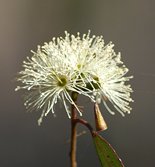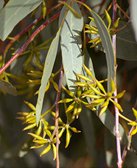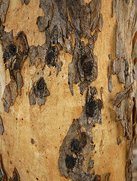Coolabah
Eucalyptus coolabah
Family: Myrtaceae
Other names:
Smooth-barked coolabah
Locations. Coolabah is a species of the arid
and semi-arid zones of Australia. It is characteristically a
species of very open savannah around the edges of swamps and
lagoons or in the open belts along water courses. E.
coolabah is very similar to E. microtheca. The
main external difference is that the latter has completely smooth
bark.
Western coolabah (Eucalyptus
victrix). Found on floodplains in the north-west of
the country, western coolabah was originally considered to be a
form of coolabah proper (Eucalyptus coolabah), but
differs in its attractive stark white trunk. It is a
small-to-medium sized, slow-growing tree with an open habit and
lanceolate
grey-green leaves. The small white flowers occur over summer.
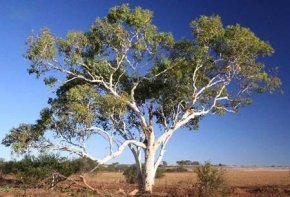
Photo by Cas Liber
http://asgap.org.au/e-vic.html
Naming. The plant
is commonly called "coolabah" or "coolibah", the name being a
loanword from the Indigenous Australian Yuwaaliyaay tribe word,
"gulabaa".
Appearance. Coolabah is generally a small
tree, 15-21 m in height, with a moderately-to-poorly formed
bole 1/4 to 1/3 of the height of the whole tree, and up to
1 m in diameter. The tree has an open, straggly crown and a
trunk only up to 1 m to the first large branches. Bark
usually remains on the trunk and large branches.
It is shortly sub-fibrous, rough and grey to almost black
(Eucalyptus coolabah) or smooth and white
(Eucalyptus victrix).
Uses.
The timber of coolabah is used to a limited extent for fencing
and fuel.
Properties. The tree produces some of the
hardest and densest timber on Earth. The wood is dark-brown to
black, with numerous vessels with white contents. The timber is
hard, very dense and durable and has interlocked grain. Sapwood
is whitish and narrow. It is insect-resistant.
Grasstree
Xanthorrhoea Preissii
Family: Mimosaceae
Other names: Black
boy
What is it? Grasstree or "Black boy" is
uniquely Australian and a common part of the Australian
landscape. It fascinated the first European settlers, since
grasstree was unlike any other known plant. In fact, it is a
living relic developed early in the evolutionary stakes for
flowering plants.
The grasstree is actually not a tree, but a woody plant. It
is related to the lilies, but is placed in a separate family.
They are close relatives with the sagg (Lomandra
longifolia) with which it shares many attributes.
Location. Grasstrees grow in all the states
of Australia. There are a total of 15 species, 7 of which are to
be found in Western Australia.
Appearance. This plant can grow to a height
of over 4 m and often has branches.
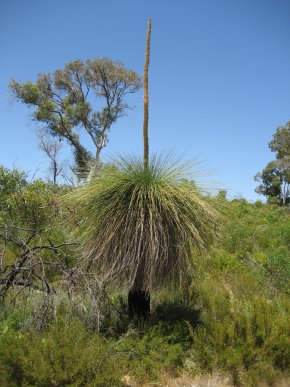
Branch development is considered to be caused by
bushfire.
The trunk takes a decade or more to form as it
is composed of a mass of old leaf bases bound together by the
plant's natural resin. The trunk at the top bears a skirt of
long narrow and tough grass-like leaves up to a meter or more in
length. The plants are very slow growing, with growth rate of
only about 1 m per 100 years.
However, the flowering stalk grows at a rate of 2-3 cm
per day reaching to a height of over 3 m. Mature plants will
result in flowering every 2-3 years.
The flower stalk appears as a long cylindrical spike
(1 to 3 m) rising out of the skirt of leaves,
often flowering as a direct response to a very recent bushfire.
This ability to be one of the first flowers to appear after a
fire ensures a food source for many insects and birds, in an
otherwise alien, blackened moonscape environment. The tops of
these spikes are covered with a dense pattern of tiny
white-to-yellow florets. These in turn produce seed capsules
containing a few hard black seeds.
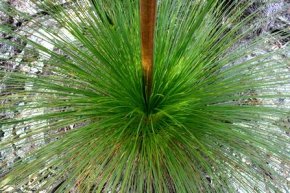
Timber properties. The wood-like material
sought after by wood-turners is only found in the West Australian
species Xanthorrhoea Preissii; this species is mostly
found in the south-western corner of the state. The "wood" is
really compressed and bonded fibres, and the spots or dots one
sees on a turned piece are the centre marks of the previous
leaves. It displays rich colours from golden honey through to
dark-brown, almost black. The "grain "pattern is thought to be
caused by the different growing conditions e.g. drought, floods
and bushfires.
The woody piece is formed at the root level, and the fibrous
material bonds it together with the trunk.
Unless the grasstree has been dead for several years, and the
fibrous material has composted away, it is near impossible to
harvest the woody cores. The cores are rarely large enough to
make more than one article. Turning the cores or stumps is
dusty, one doesn't cut shavings as with proper wood, just coarse
sawdust-like dust, which is a health hazard, and proper
precautions need to be taken.
Uses. The plant was very useful for
Aborigines in tool crafting.
The light, straight flower
stalk served as a butt-piece for spears. A tip section of tea
tree would then be attached to the end of the spear and hardened
in the fire before used for hunting. Mainland Aborigines used
pieces of very dry flower stalk for making fire with a drilling
stick.
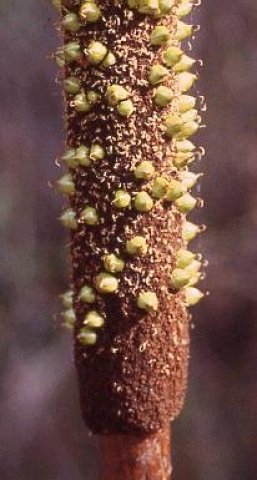
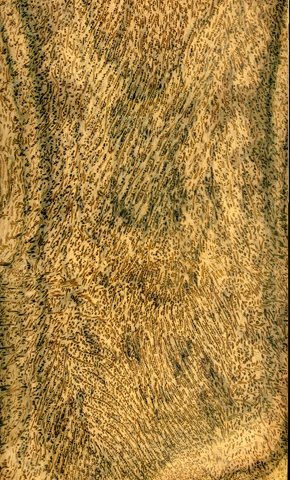
The leaves produce a hard waterproof resin, which could be
collected from the base of the trunk. This resin melts when
heated, but sets hard when cold. It had a number of uses
including:
- Forming glue by mixing it with charcoal,
beeswax or fine sand and dust.
- Gluing the cement stone heads to wooden handles and
spears to shafts and tips.
- Waterproofing bark canoes and
water carrying vessels.
The versatility of this resin in the everyday lives of the
Aborigines made it a valuable trading item and was traded amongst
tribes for other important collectables.
The grasstree "wood" is extensively used by Australian
woodturners. The wood provides a rich variety of colours and
grain patterns and is an exciting medium to work with, in spite
of the hazardous dust problem.
Huon pine
Lagarostrobos franklinii Hook.f.
Family:
Podocarpaceae
Other names: Macquarie pine, White pine
Related species. The tree is not a true
pine. It is closely related to Dacridium cupressinium
Soland, from New Zealand known as "rimu".
Locations. Huon pine grows nowhere else on
Earth but in the cool wet rainforests of the west coast of
Tasmania.
History of the name. The tree was called
after Captain Jean-Michel Huon de Kermadec, commander of the
French ship L'Esperance. Captain de Kermadec was one of
lieutenants of the French expedition dispatched in 1791 to the
Pacific to search for vanished fellow explorer, Comte de La
Perouse. De Kermadec lent his surname to an archipelago in the
Pacific. However, his first name was even more widely deployed,
attached to the Huon River, the Huon Valley, the Huon Peninsula,
the Huon Gulf, Huonville and, most famously, the Huon pine.
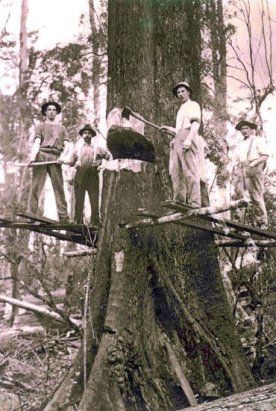
Logging Huon pine
(Image
courtesy of the Tasmanian Salvaged Resurrection Timbers Pty Ltd)
Logging restrictions. Prior to European
settlement, the Huon pine existed in large numbers, but their
unique qualities resulted in most trees being felled. (A
detailed history of timber industry in Tasmania can be found here.
Mining and fire reduced a number of Huon pine trees further. The
exploited Tasmanian forests were disappearing at an alarming
rate, with very few signs of regenerating. Today, the felling of
Huon pine is restricted and the tree is protected within reserves
with the majority being within the World Heritage Area.
Huon pines can be seen growing freely along the Denison
River. Timber is still available through natural felling that
provides craftsmen access to their wood.
Appearance. Huon pine is a moderately tall
tree, usually 20-25 m high and up to 0.7 m in diameter,
but has been known to grow to 38 m. The trunk is straight,
with very little taper, whilst buttresses are rarely developed.
It has a slightly rough grey bark which, having been hewn, will
weather to a beautiful silver colour.
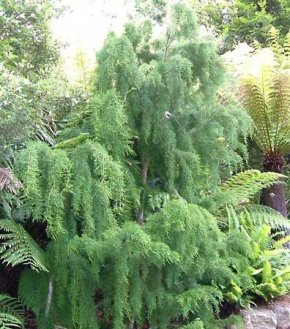 Huon Pine in a Tasmanian botanical garden (Wikipedia)
Huon Pine in a Tasmanian botanical garden (Wikipedia)
Huon pine is one of the slowest-growing and longest-living
trees in the world. It grows on average 1 mm per year and it
takes 600 years or more to reach tree maturity. The tree
can grow to an age of 3000 years or more. In 1994, a stand
of Huon pines was discovered on Mount Read, that were existing
there, as vegetatively reproducting plants, for over
10 000 years. Pollen records indicate that Huon pine
was growing 135 million years ago, when the great
super-continent Gondwana existed. Although only found growing in
Tasmania, it is related to species in Chile, Malaysia and New
Zealand.
Properties. The heartwood is a pale yellow to
yellowish-brown with a straight grain and extremely fine texture
with very distinct growth rings. It weights about
530 kg/m3. The wood has very low stiffness and
resistance to shock loads, medium bending and crushing
strengths. It is durable and resistant to insect attack.
The tree contains an essential oil, methyl eugenol, which
gives the wood its characteristic smell, repels insects and makes
it very durable.
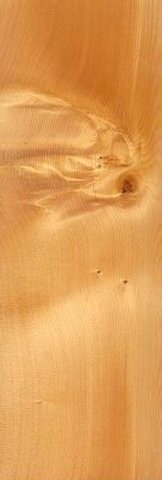
This fragrant softwood is easily wrought with hand and
machine tools.
It plains and moulds cleanly, but may tend to split on
nailing and require pre-boring. The wood takes glue, stain and
polish easily and can be brought to a good finish.
Uses. Huon pine is a very sought-after timber
by craftspersons and designer/makers and is in extremely short
supply. It is one of the best boat-building timbers due to its
durability and natural oil, making it resistant to water
penetration. Once cut, logs can remain intact, even in water,
for thousands of years. Radio carbon dating indicates that two
logs found recently in a west coast river were alive over
7,000 years ago.
The timber is used in cabinet work, joinery, furniture-making;
selected logs are sliced for decorative veneers.
Jarrah
Eucalyptus marginata
Family:
Myrtaceae
Other names: Swan River mahogany
Location. Jarrah is one of Australia's well
known and most important hardwoods which is endemic to the
south-western corner of Western Australia. It mainly grows in
the relatively wet forests where rainfall is in the
700-1250 mm per annum range.
History. Old growth jarrah and karri forests
of Western Australia have been extensively cut since 1880s. At
the turn of the 20th century, 50% of Western Australia's timber
exports went to Great Britain as street paveing blocks.
Currently, despite of relatively poor burning qualities, about
45% of the harvested jarrah is used for firewood and charcoal
production (The West Australian, 8 April 2008).
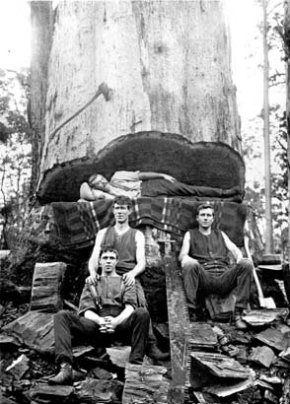 Logging giant jarrah trees near Jarrahdale, 1910s.
Logging giant jarrah trees near Jarrahdale, 1910s.
(Image courtesy of the Battye
Library, Western Australia.)
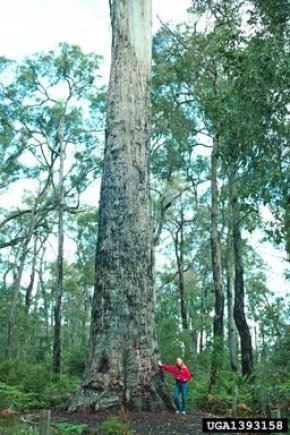
Image of a jarrah tree: 47 m high, 2.7 m in diameter
and 1200 years old.
Photo by Dennis Haugen,
http://bugwood.org
Appearance. Under
favourable conditions, jarrah can attain a height of 40 m or
more and the trunk diameter can be up to three metres. However
in poor conditions it may only grow 2 m high. The tree
trunk is long, straight, and has no branches on it. It has
rough, greyish-brown fibrous bark which sheds in long flat
strips. Mature trees have been known to be over 1000 years
old.
Properties. Heartwood shows variety of
colours ranging from light-pink to chocolate brown. The darker
the colour the older the wood. Jarrah that has been air-dried
and exposed to ultra-violet rays for many years is darker than
wood that has been kiln dried. Ultimately, all Jarrah will end
up a rich chocolate brown with age.
The timber is sometimes marked by short, dark-brown radial
flecks on the end grain and boat-shaped flecks on flat sawn
surfaces which enhance its decorative value. These marks are
caused by fungus Fistulina hepatica. Gum veins or
pockets may also be present. The grain is usually straight but
often interlocked and wavy. The texture is even but moderately
coarse.
The weight is ranging
690-1040 kg/m3 with an average of
800 kg/m3. This heavy timber has high crushing
strength and medium bending strength. It is very durable and
highly resistant to insect attacks.
The material is
rather difficult to work with hand tools, and fairly hard to
machine with high resistance to cutting edges and a moderate
blunting effect. Gluing properties are good and the wood
polishes very well. The only weakness of the jarrah is its
sensitivity to direct sunlight. The unprotected timber is
darkening over few years even from strong reflected light.

Uses. The long, straight, branch-free bole,
durability in wet and weathered conditions and resistance to
termites made it the first choice for bridge and wharf
construction, railway sleepers, ship building, telegraph poles,
house frames and, before the advent of bitumen roads, paving
blocks for many city streets in London, Berlin and other European
cities.
The finished timber with its magnificent, deep, rich, reddish
brown colour and attractive grain is sought after for flooring,
panelling, furniture making and has been specified in both
commercial and residential projects worldwide.
Jelutong
Dyera constulata & D.
lowii
Family: Apocynaceae
Other names: Jelutong bukit, Jelutong
paya
Locations. Jelutong has been traditionally
overharvested, and is a threatened species in many areas.
However, due to its quick growth, hardy survival and strong
replanting efforts, its extinction is unlikely. It is a
protected species in parts of Malaysia and Thailand. The tree is
grown commercially for timber.
Appearance. Jelutong is related to the
oleander subfamily. It commonly grows to 60 m in height with
up to 2 m in diameter, with some trees found up to 35 m
in height. Bole is clear and straight for 30 m. The tree
grows in low-elevation tropical evergreen forests of Malaysia,
Borneo, Sumatra and southern Thailand.
Properties. Although technically a hardwood,
jelutong has many properties similar to balsa wood.
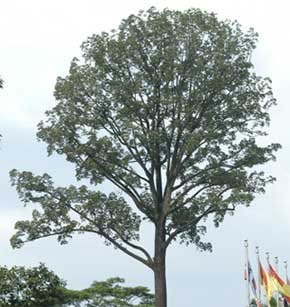 Jelutong tree at Tower Forest Park, Kuala
Lumpur
Jelutong tree at Tower Forest Park, Kuala
Lumpur
It is rather light (460 kg/m3) for a
hardwood, soft, brittle, and weak with good stability, low decay
resistance, and a poor steam bending rating. Wood is
straight-grained with fine, even texture. Creamy-white sapwood
and heartwood, maturing to a pale straw-yellow.
Works easily with both hand and power tools and planes to a nice,
clean surface. Glues, screws, and nails without difficulty.
Stains, paints, and varnishes fairly well.
Uses. Popular for model making, patterns,
wooden shoes, battery separators, and drawing boards. Also used
for interior joinery and corestock for doors. Jelutong is best
used for sculpture and carving, architectural models,
patternmaking, picture frames, drawing boards and craft work.
Latex in the wood was extracted for chewing gum.
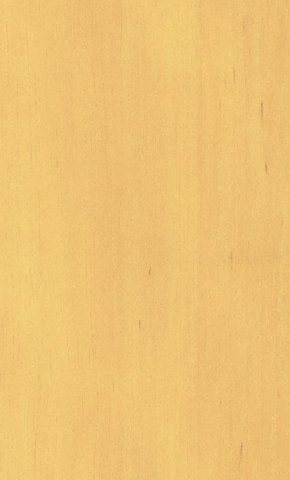
Mallee
Eucalyptus (dwarf form)
Family: Myrtaceae
What are they? Mallee is an Aboriginal name
for a dwarf form of eucalypts which are widespread in arid and
semi-arid regions, mainly in the southern parts of Australia.
Over 50% of approximately 800 species of Eucalyptus are
known as mallees.
Farmer's enemies. Australian settlers in the
late 1800s clearing the mallee-dominated areas for farming met
enormous problems. At first, the farmers simply knocked over the
thin mallee stems with horse-drawn balls and chains, burned the
vegetation and ploughed the land. Ploughing was extremely
difficult as the ploughs were continually being broken by the
rock-solid mallee "roots". Many farmers gave up. The stump-jump
plough invented in 1876 slightly improved the situation.
However, it wasn't long before the farmers confronted another
problem - the amazing ability of mallee eucalypts to regenerate
from their rootstocks. New stems grew as quickly as the wheat and
no matter how frequently they were cut off they were replaced.
Digging out individual roots was far too expensive in time and
labour. Some farmers attempted to grow special long-strawed
varieties of wheat. The ears of wheat would grow above the
mallee shoots; they could then be harvested and the thick stubble
which was produced could be burned after the harvest. It was
hoped this burning would destroy the mallee stems along with the
stubble.
However, after burning, the mallee root-stocks
produced even more vigorous shoots. Struggle with mallees took a
lot of years of cutting and burning. Today, at least 75% of the
original Mallee vegetation in South Australia and about 60-65% in
Victoria has been cleared and developed for farming.
That, as usual with human "victories" over nature, created
serious ecological problems,
e.g. groundwater and
soil salinity and soil erosion.
Dryland salinity has become a major problem for agriculture
in the mallee areas and enormous research and monitoring efforts
have been made over the past couple of decades.
Ironically, the best ecological solution would appear to be
replanting mallees, thus removing any agricultural benefit, so
that the water table balance can be restored.
Appearance. Trees grow to a height of
2-9 m and instead of a single trunk, mallees have many stems
that rise from a bulbous woody base called a lignotuber, or
mallee root. In fact, the mallee root is not a root at all but
is essentially a very contracted underground trunk which grows
just below the surface and from which the stems arise. It acts
as both a storage and reproductive organ.
The "root" is
rich in nutrients and stores some water so that the mallee can
survive long periods without rain. Multiple growth points allow
rapid development of new shoots if the above-ground parts of the
plant be destroyed by fire or other natural catastrophes.
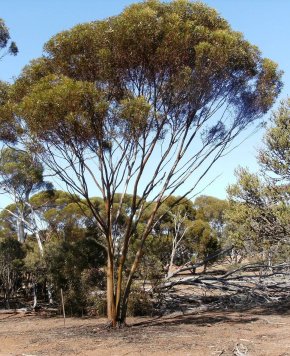 Mallee tree near Esperance, southern Western
Australia.
Mallee tree near Esperance, southern Western
Australia.
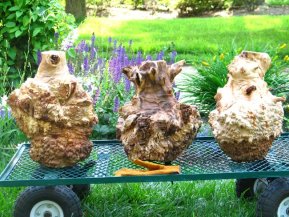 Mallee "root" balls.
Mallee "root" balls.
Photo by
Jim Syvertsen
http://australianburls.com
Most other species of
Eucalyptus have similar epicormic shoots on their trunks
and larger branches from which new shoots can develop after fires
but the mallee protects the trunk much more efficiently.
Properties and uses. For many years mallee
was only valued as firewood. Today, in spite of the fact that
they are extremely hard and therefore difficult to work with,
they are prized for their stability and their beautifully marbled
grain which takes a superb finish.
Nice examples of the mallee timber colours and textures could
be seen on a web, for example here.
Mulga
Acacia aneura
Family:
Mimosaceae
Location. Mulga is a common plant in
Australia's dry inland areas. It is the most common member of the
genus Acacia, and one of the 880 species of
Acacia (75% of the world's Acacias) found in
Australia. Mulga grows on flood and erosion plains, and
scattered on slopes and ridges. It is generally found in low
open woodland or tall shrubland, often in pure stands, but may be
found with mallees, low shrubs and grasses.
Naming. Mulga was often used by Aboriginal
people to make spears and long narrow shields called
"mulgas".
Age. The species has a very wide distribution
in Australia and grows in all states except Victoria and
Tasmania. Among the acacias, many of which are relatively
short-lived, mulga can live for up to 400 years. In
favourable conditions young plants will grow at a rate of
1 m every 10 years until the tree reaches its maximum
height 7-10 m.
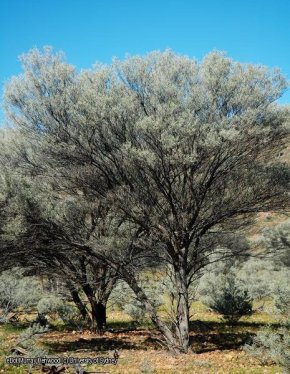 Photo by Murray Henwood
Photo by Murray Henwood
http://www.mjhall.org/mulga.php
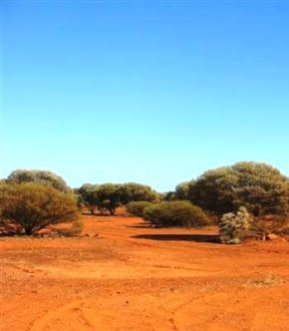 Mulga country, near Meekatharra,
Mulga country, near Meekatharra,
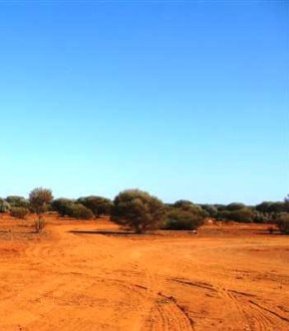 central Western Australia
central Western Australia
Reduced rainfall or drought conditions will slow down this
process or bring it to a temporary halt, which means that a
mature tree will usually be more than 100 years old. The
counting of growth rings on felled trees has revealed the
stunning number of 150-240 rings in stems of only 25 cm
diameter. In their lifetime these trees would have experienced a
number of drought years when no growth rings develop and
therefore grew older in years than the exact number of growth
rings indicate.
The resourceful way in which the plant utilises every drop of
moisture assists its survival to such a proud age.
A
sophisticated arrangement of its phyllodes and branches ensures
that rainwater is channelled to the stem and onto the ground
right to its deep taproot (seedlings of only 10 cm height
have been found to have taproots reaching 3 m deep into the
ground).
(Photography by S.D.Hopper et al.
http://florabase.dec.wa.gov.au)
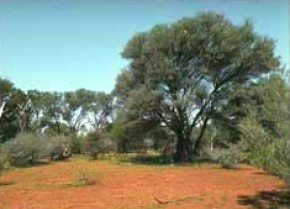
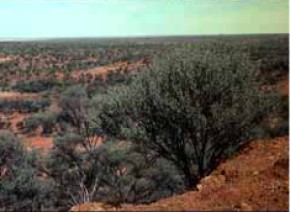
Appearance. Mulga has varying forms, from a
multi-branched shrub of 1 m to a small tree up to 10 m
tall. This bird-attracting tree has pretty yellow flowering
spikes, which appear after heavy rains.
Properties. The heartwood is dark-brown, with
contrasting markings of golden yellow. There is a narrow band of
yellowish sapwood. The wood is close-textured and very hard.
Wood is very durable, air-dry density is about
1200 kg/m3. Goldfields area craftsmen rate mulga
as good for turning, machinability, drilling, screwholding and
gluing, and excellent for sanding and finishing.
Uses. The hard and durable wood of mulga was
for all central Australian Indigenous groups the most important
source of wood for making tools such as spear-throwers,
spearheads, barbs, boomerangs and digging sticks. One such a
tool, a small, flat shield called "mulga" by one Aboriginal tribe
gave the plant its common name. Mulga wood was also used
extensively by the early settlers.
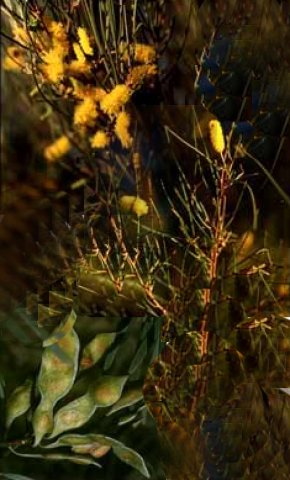
It was particularly valuable for fencing, the production of
charcoal and for building bullock yokes and the multitude of uses
lead to massive clearings of mulga in some areas, further
compounded by the devastating impact of feral goats.
To
Aboriginal people in Australia, mulga used to be one of the most
important plant food sources. After cleaning, the hard-coated
seeds were roasted and then ground into a paste similar in taste
and texture to peanut butter, but much more nutritious. A sweet
exudation, produced by the plant after attack by a sap-sucking
insect, was either sucked straight from the plant or dissolved in
water to make a refreshing sweet drink. This was also eaten by
early settlers who referred to it as "bush lollies".
A
white, powdery substance on mulga leaflets and small branches was
used as a source of resin for joining tool-parts and for
repairing cracks or holes in wooden bowls.
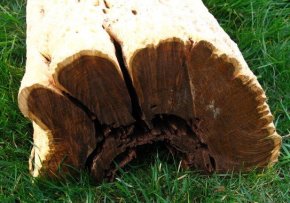 http://australianburls.com
http://australianburls.com
Aborigines in the Northern
Territory utilised the healing qualities of mulga in various
ways. People suffering from colds used young leaflets and twigs
which were picked and boiled in water. The brown, aromatic liquid
was then used as a wash. Headaches associated with colds could be
eased by heating young leaves and twigs on hot ashes or hot
stones until soft and scorching, when they were placed over the
aching area.
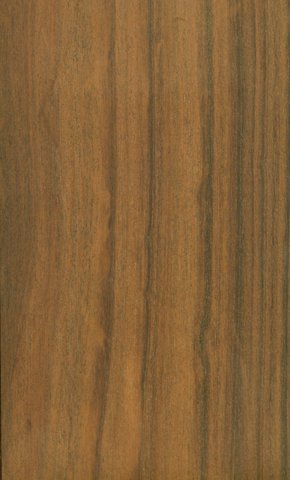
Red morrell
Eucalyptus longicornis
Family: Myrtaceae
Appearance. Red morrell is a medium-to-tall
tree, up to 30 m. The rough grey bark up to the branches has
a stringy texture, with smooth grey bark on the branches. The
species is common in the inland Western Australia in south-east
Goldfields and in the Wheatbelt to Coorow.
Properties. Wood is red to red-brown, strong
and durable, used formerly by wheelwrights.
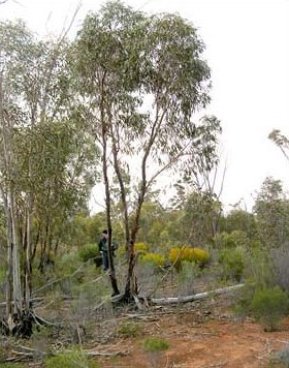 Photo by G.F.Craig.
Photo by G.F.Craig.
Courtesy of Western Australian Herbarium.
River red gum
Eucalyptus camaldulensis,
Dehnh.
Family: Myrtaceae
Other names: Murray red gum, Queensland blue
gum, Red gum
Locations. River red gum is one of the most
common inland trees of Australia found along watercourses
throughout all states except Tasmania, and is probably the tree
which is most synonymous with the Australian outback.
It
grows under a wide range of climatic conditions from tropical to
temperate, but the main areas are characterised by
5-20 frosts in winter and high summer temperatures.
Related species. The tree is related to the
red gum group, comprising about thirty species and varieties.
Distinction between species is rather difficult.
River red gum and Tasmanian blue gum are the most widely
planted eucalypts overseas.
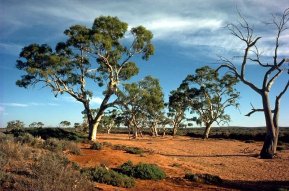 Photo by D.Kleinig.
Photo by D.Kleinig.
http://www.anbg.gov.au
The greatest success with river red
gum has been in semi-arid areas bordering the Mediterranean,
notably in Israel and North Africa.
Appearance. River red gum is a
medium-to-moderately-tall tree, usually with a large diameter.
It is commonly 25-35 m high, but attains 45 m, whilst
diameters are 1-2 m or even greater. The crown is large and
in open formation the tree usually has a short thick bole.
Despite of nice shade the tree gives, it is inadvisable to
erect a tent or any building under the red gum tree because,
during the hot spells of weather, it has a tendency to drop a
limb without any warning.
Most of the trees of the red gum
group shed patches of their bark each year, so that the surface
is relatively smooth, but blotched with various colours. The
decorating bark may hang from the trunk in reddish strips,
further adding to the pattern of colours.
Properties . The heartwood colour varies
according to location and age, from pink to red. The grain is
interlocked and frequently wavy which produces a fiddleback
figure when quarter cut. The texture is close and even. The
wood is resinous with frequent gum pockets. The surface is often
distinctly mottled. The specific gravity is
825 kg/m3.
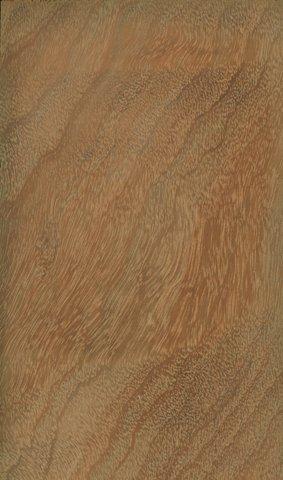
The timber has excellent strength properties but is not used
for steam bending due to the exudation of gum. It is very
durable with a natural high resistance to insects. The wood is
difficult to work with both hand and machine tools due to the
presence of gum. The interlocked grain requires a reduced
cutting angle of 20 degrees to prevent tear out. Can be
brought to a good finish.
Uses. The strong and very durable timber was
widely used in the past for housing, heavy construction and
fencing.
Today this rich red hardwood is used for
furniture, flooring, turning and decorative wood work. In the
late 1980s some red gum logs were discovered buried in what was
once a swamp, that have been dated at 5000 years old. The timber
has turned from deep red to almost black in colour but otherwise
has been unaffected.
Parts of the tree are used to treat head colds by the
Aborigenes, its foliage is relished by Koalas.
Rose gum
Eucalyptus grandis Hill ex
Maiden
Family: Myrtaceae
Other names: Flooded gum
Locations. Rose gum is native to the east
coast of Australia. The tree is one of the premier forest
species in the Australian states of Queensland and New South
Wales.
Rose gum is one of the most important commercial
Eucalypts, with more than one-half million hectares
planted in tropical and subtropical areas on four continents.
Massive planting programs have been carried out in the
Republic of South Africa and Brazil, and there are substantial
plantings in Angola, Argentina, India, Uruguay, Zaire, Zambia,
and Zimbabwe. In southwest Florida rose gum may be an emerging
commercial species for plantations.
Appearance. Rose gum is a tall tree ranging
in height from 43 to 55 m.
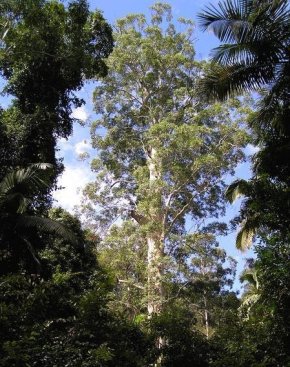 Photo by Andrew Perkins,
University of Sydney
Photo by Andrew Perkins,
University of Sydney
The diameters are not large in relation to the height and are
usually 1.2-1.8 m. Its form is good with tall, straight,
clean trunk up to two-thirds of the total height.
The
bark is thin and deciduous, shedding in strips to expose a smooth
surface marked with flowing patterns of silvery white, slaty
gray, terracotta, or light green. Occasionally a "stocking" of
light-gray, plate-like or fissured bark persists over the basal
1 to 2 m on the trunk.
Uses. Rose gum timber is used for general
construction, joinery, plywood, panelling, boat building,
flooring, utility poles, mine timbers, and posts. It is a very
underestimated timber in relation to cabinetry.
Properties. The sapwood of rose gum is pale
pink and the heartwood light to dark red. The wood is
straight-grained, coarse-textured, and moderately strong. It is
moderately durable at best, but the sapwood is generally
resistant to Lyctus spp. borers.
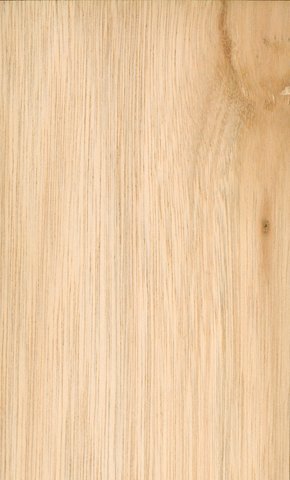
The specific gravity varies from
620 to
800 kg/m3, averaging at
750 kg/m3.
The timber is relatively easy to work, dry and glue.
Salmon gum
Eucalyptus salmonophloia
Family: Myrtaceae
Appearance. Probably the best known Eucalypt
in the Goldfields and Wheatbelt of Western Australia. It is one
of the larger trees of the inland semi-arid areas of Western
Australia. Commonly it is 20-25 m in height and up to 0.6 m in
diameter. The trunk is relatively short, about one-third of the
tree height. Whilst the umbrella-shaped crown is large, it
usually has sparse foliage.
The distinctive feature of the salmon gum is salmon pink
colour of the underbark; bark usually shed from the trunk in
large patches, leaving a smooth salmon pink surface.
"Salmon
Gums near Salmon Gum, Esperance Region, WA.
Properties. Wood - pink to red to red-brown;
strong, durable and dense at 1070 kg/m3.
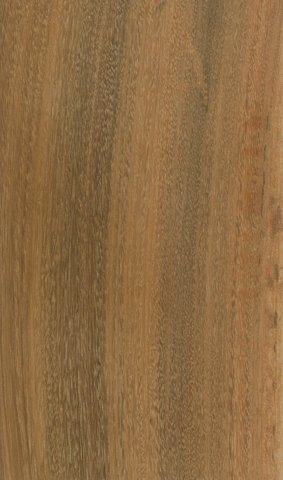
Uses. The wood had a long history of use in
underground mines, and the dense, fine-grained and attractive
timber has gained popularity for panelling and flooring. It is
being experimented with in musical instrument manufacture,
particularly as flute head joints.
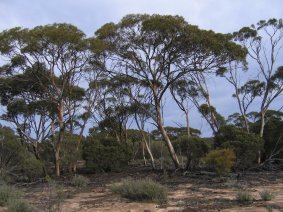
Wandoo
Eucalyptus
redunca
Family: Myrtaceae
Other names: White gum
Appearance. Wandoo is commonly called "white
gum". Though usually a small tree up to 20 m in height, it
is occasionally found up to 35 m in height and 1.2 m in
diameter. Wandoo grows in the savannah woodland zone with
380 to 500 mm rainfall in south-west of Western
Australia.
The tree has smooth white bark with red patches or
occasionally with persistent fibrous, flaky yellow-brown bark
over the lower part. The trunk is from a third to half the tree
height. The crown is large, but comparatively lightly
branched.
Photography by A.Ireland.
Courtesy of Western
Australian Herbarium.
Properties The heartwood is yellow to
light-reddish-brown, and the sapwood band is very narrow.
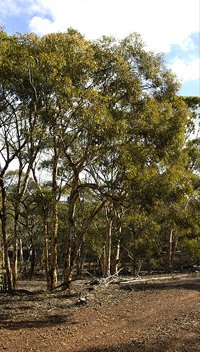
Wood is
close-textured, with wavy or interlocked grain. Very hard and
very strong durable and dense (1100 kg/m3). Bark
and wood contain 10-12% tannins.
Uses. The timber is well-suited for use
where high strength, durability and resistance to abrasion is
needed. Formerly it was used in wheelwright and wagon
construction due to high resistance of the wood to chemical
reactions with metal fastenings. The timber is used in all forms
of light and heavy construction works. It is particularly
suitable for heavy duty flooring where strength and hard wearing
properties are critical.
